Related Research Articles
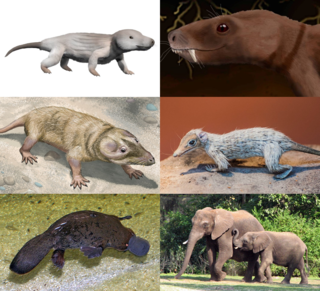
The cynodonts are a clade of eutheriodont therapsids that first appeared in the Late Permian, and extensively diversified after the Permian–Triassic extinction event. Cynodonts had a wide variety of lifestyles, including carnivory and herbivory. Mammals are cynodonts, as are their extinct ancestors and close relatives, having evolved from advanced probainognathian cynodonts during the Late Triassic. All other cynodont lines went extinct, with the last known non-mammalian cynodont group, the Tritylodontidae having its youngest records in the Early Cretaceous.

Cornelia is a small town on the R103 road in the Free State province of South Africa. In 1875 D.J. Steyn bought the farm "Mooiheid" and J.D. Odendaal bought the farm "Sugarloaf" for a sum of R2000. They settled there in 1876. At that time it was in the Harrismith district. There were no boundary fences and wild dogs, warthogs and wildebeest were plentiful in the open grassveld.

Tritylodon is an extinct genus of tritylodonts, one of the most advanced group of cynodont therapsids. They lived in the Early Jurassic and possibly Late Triassic periods along with dinosaurs. They also shared many characteristics with mammals, and were once considered mammals because of overall skeleton construction. That was changed due to them retaining the vestigial reptilian jawbones and a different skull structure. Tritylodons are now regarded as non-mammalian synapsids.

Antetonitrus is a genus of sauropod dinosaur found in the Early Jurassic Elliot Formation of South Africa. The only species is Antetonitrus ingenipes. As one of the oldest known sauropods, it is crucial for the understanding of the origin and early evolution of this group. It was a quadrupedal herbivore, like all of its later relatives, but shows primitive adaptations to use the forelimbs for grasping, instead of purely for weight support.
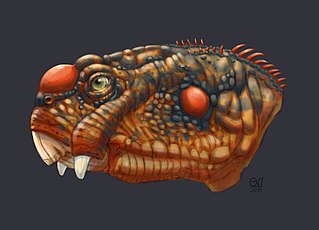
The Daptocephalus Assemblage Zone is a tetrapod assemblage zone or biozone found in the Adelaide Subgroup of the Beaufort Group, a majorly fossiliferous and geologically important geological Group of the Karoo Supergroup in South Africa. This biozone has outcrops located in the upper Teekloof Formation west of 24°E, the majority of the Balfour Formation east of 24°E, and the Normandien Formation in the north. It has numerous localities which are spread out from Colesberg in the Northern Cape, Graaff-Reniet to Mthatha in the Eastern Cape, and from Bloemfontein to Harrismith in the Free State. The Daptocephalus Assemblage Zone is one of eight biozones found in the Beaufort Group and is considered Late Permian (Lopingian) in age. Its contact with the overlying Lystrosaurus Assemblage Zone marks the Permian-Triassic boundary.

The Lystrosaurus Assemblage Zone is a tetrapod assemblage zone or biozone which correlates to the upper Adelaide and lower Tarkastad Subgroups of the Beaufort Group, a fossiliferous and geologically important geological Group of the Karoo Supergroup in South Africa. This biozone has outcrops in the south central Eastern Cape and in the southern and northeastern Free State. The Lystrosaurus Assemblage Zone is one of eight biozones found in the Beaufort Group, and is considered to be Early Triassic in age.

The Cynognathus Assemblage Zone is a tetrapod biozone utilized in the Karoo Basin of South Africa. It is equivalent to the Burgersdorp Formation, the youngest lithostratigraphic formation in the Beaufort Group, which is part of the fossiliferous and geologically important Karoo Supergroup. The Cynognathus Assemblage Zone is the youngest of the eight biozones found in the Beaufort Group, and is considered to be late Early Triassic (Olenekian) to early Middle Triassic (Anisian) in age. The name of the biozone refers to Cynognathus crateronotus, a large and carnivorous cynodont therapsid which occurs throughout the entire biozone.

Epicynodontia is a clade of cynodont therapsids that includes most cynodonts, such as galesaurids, thrinaxodontids, and Eucynodontia. It was erected as a stem-based taxon by Hopson and Kitching (2001) and defined as the most inclusive clade containing Mammalia and excluding Procynosuchus, a Late Permian genus that is one of the most basal cynodonts.

Bauria is an extinct genus of the suborder Therocephalia that existed during the Early Triassic period, around 246-251 million years ago. It belonged to the family Bauriidae. Bauria was probably a carnivore or insectivore. It lived in South Africa, specifically in the Burgersdorp Formation in South Africa.
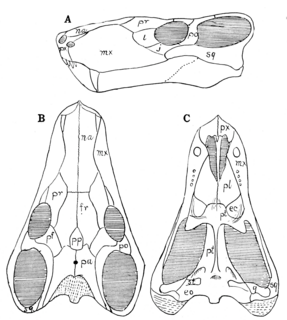
Scylacops is an extinct genus of Gorgonopsia. It was first named by Broom in 1913, and contains two species, S. bigendens, and S. capensis. Its fossils have been found in South Africa and Zambia. It is believed to be closely related to the Gorgonopsian Sauroctonus progressus. Scylacops was a moderately sized Gorgonopsid.
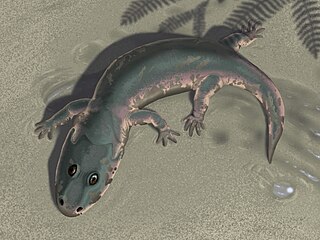
Cryobatrachus is an extinct genus of temnospondyl amphibian from the Early Triassic of Antarctica. The type species is Cryobatrachus kitchingi. It is known from a partial skull and an imprint of the skull roof, both found in the Fremouw Formation of the Transantarctic Mountains at about 85° south latitude and described in 1974. Many small bone fragments have also been identified, although they cannot be attributed with certainty to C. kitchingi. Cryobatrachus has been classified in the family Lydekkerinidae, as it is similar in appearance to the genus Lydekkerina from South Africa. Because only a small number of features distinguish it from other lydekkerinids, Cryobatrachus kitchingi has more recently been considered a nomen dubium, meaning that its distinction from other better-known species may be unwarranted.
Cynosaurus is an extinct genus of cynodonts. Remains have been found from the Dicynodon Assemblage Zone in South Africa. Cynosaurus was first described by Richard Owen in 1876 as Cynosuchus suppostus. Cynosaurus has been found in the late Permian period. Cyno- is derived from the Greek word kyon for dog and –sauros in Greek meaning lizard.

Lumkuia is an extinct genus of cynodonts, fossils of which have been found in the Cynognathus Assemblage Zone of the Beaufort Group in the South African Karoo Basin that date back to the early Middle Triassic. It contains a single species, Lumkuia fuzzi, which was named in 2001 on the basis of the holotype specimen BP/1/2669, which can now be found at the Bernard Price Institute in Johannesburg, South Africa. The genus has been placed in its own family, Lumkuiidae. Lumkuia is not as common as other cynodonts from the same locality such as Diademodon and Trirachodon.
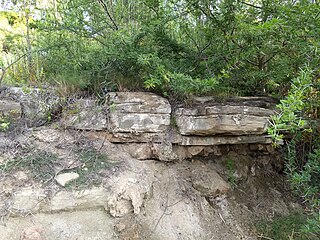
The Sundays River Formation is a geological formation found in the Eastern and Western Cape provinces in South Africa. It is the second youngest of the four formations found within the Uitenhage Group of the Algoa Basin, its type locality, and the only location where outcrops have been located. The Sundays River has been measured at a maximum thickness of 2,000 metres (6,600 ft).

The Stormberg Group is one of the four geological groups that comprises the Karoo Supergroup in South Africa. It is the uppermost geological group representing the final phase of preserved sedimentation of the Karoo Basin. The Stormberg Group rocks are considered to range between Lower Triassic (Olenekian) to Lower Jurassic (Pliensbachian) in age. These estimates are based on means of geological dating including stratigraphic position, lithostratigraphic and biostratigraphic correlations, and palynological analyses.
Kitchingnathus is an extinct genus of basal procolophonid parareptile from Early Triassic deposits of Eastern Cape Province, South Africa. It is known from the holotype BP/1/1187, skull and partial postcranium, which was first assigned to the more derived Procolophon trigoniceps. It was collected by the South African palaeontologist, James W. Kitching in October 1952 from Hobbs Hill, west of Cathcart. It was found in the middle or upper part of the Katberg Formation of the Beaufort Group and referred to the uppermost Lystrosaurus Assemblage Zone. It was first named by Juan Carlos Cisneros in 2008 and the type species is Kitchingnathus untabeni. The generic name honours James W. Kitching, and "gnathus", from Greek meaning mandible. The specific name meaning "from the hill", in isiZulu, in reference to the locality where the fossil was found.
Homodontosaurus is an extinct genus of therocephalian therapsids from the Late Permian of South Africa. The type species Homodontosaurus kitchingi was named by South African paleontologist Robert Broom in 1949. Broom based his description on a small skull found in the Cistecephalus Assemblage Zone near Graaff-Reinet. The skull is very small, at about 55 millimetres (2.2 in) long and 20 millimetres (0.79 in) wide. Homodontosaurus has large eye sockets and an elongated snout. The lower jaw is long, thin, and curved. Numerous small teeth line the upper jaw and are long, pointed, and round in cross-section.

Gomphodontia is a clade of cynognathian cynodonts that includes the families Diademodontidae, Trirachodontidae, and Traversodontidae. Gomphodonts are distinguished by wide and closely spaced molar-like postcanine teeth, which are convergent with those of mammals. Other distinguishing characteristics of gomphodonts include deep zygomatic arches, upper postcanines with three or more cusps spanning their widths and lower postcanines with two cusps spanning their widths. Gomphodonts first appeared in the Early Triassic and became extinct at the end of the Late Triassic. Fossils are known from southern Africa, Argentina and southern Brazil, eastern North America, Europe, China, and Antarctica.
Australochelys is an extinct genus of rhaptochelydian turtle. It is known from one species, A. africanus, that came from the Elliot Formation of South Africa. The holotype of Australochelys consists of only a skull and a fragment of the carapace, which shows both primitive and derived features. Like Proganochelys, Australochelys has large orbits and a ventral basioccipital tubercle, but like derived turtles such as casichelydians, a group containing Cryptodira and Pleurodira, it possesses a sutured basipterygoidal attachment, and a middle ear region partially enclosed laterally. These characteristics show that Australochelys is more closely related to casichelydians than to Proganochelys, and together with the former, it makes up Rhaptochelydia. The skull of Australochelys shows that an advanced hearing mechanism of turtles evolved before the appearance of modern turtles.

The Katberg Formation is a geological formation that is found in the Beaufort Group, a major geological group that forms part of the greater Karoo Supergroup in South Africa. The Katberg Formation is the lowermost geological formation of the Tarkastad Subgroup which contains the Lower to Middle Triassic-aged rocks of the Beaufort Group. Outcrops and exposures of the Katberg Formation are found east of 24 degrees on wards and north of Graaff-Reniet, Nieu Bethesda, Cradock, Fort Beaufort, Queensdown, and East London in the south, and ranges as far north as Harrismith in deposits that form a ring around the Drakensberg mountain ranges.
References
- ↑ Brink, A. S.; Kitching, J. W. (1951). "CXIII.—Some Theriodonts in the collection of the Bernard Price Institute". Journal of Natural History. Series 12. 4 (48): 1218. doi:10.1080/00222935108654253.



